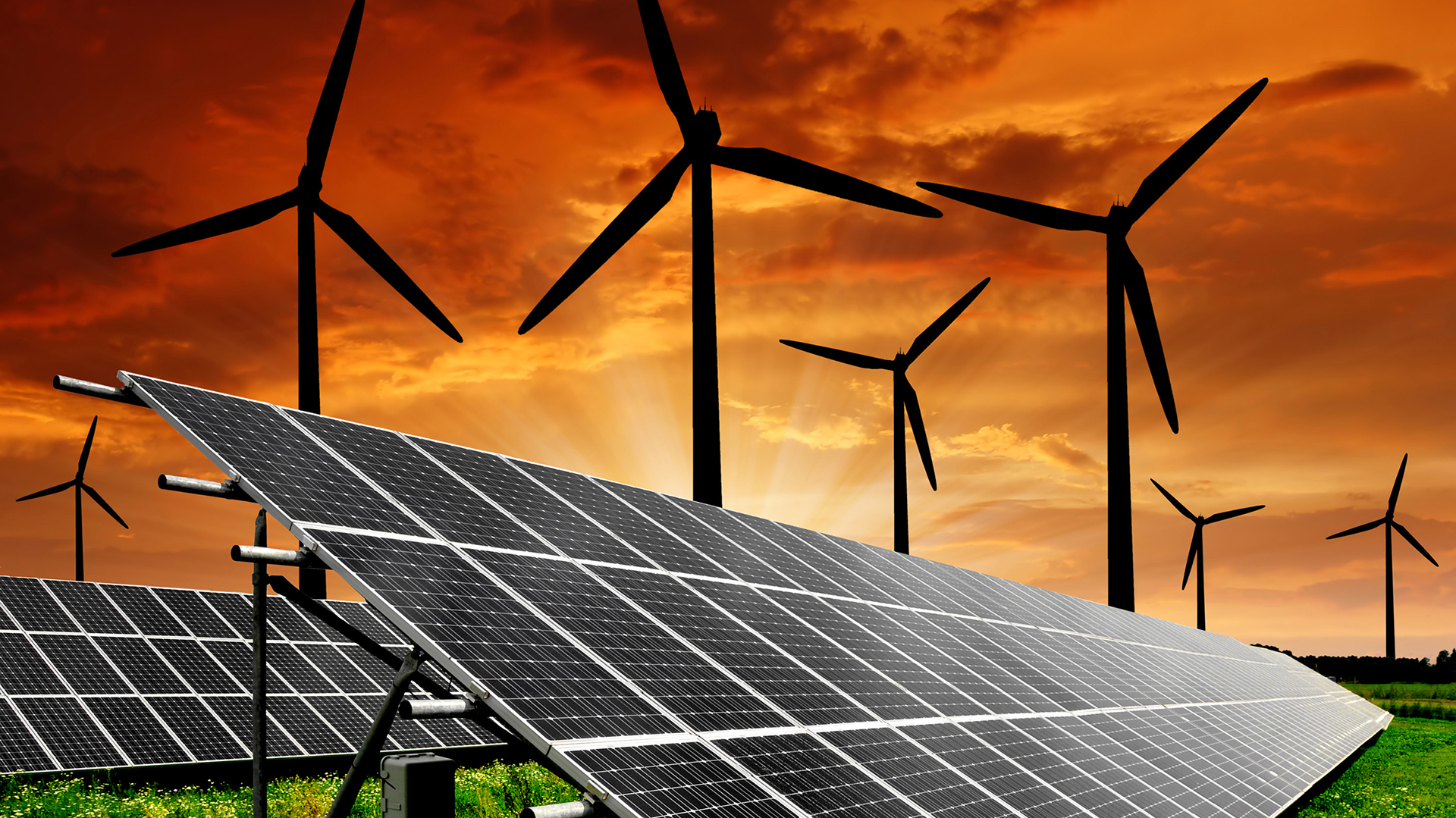
Getting a greener grid
ASU engineering experts point to priorities for expanding clean energy infrastructure

Above: Renewable energy generation technologies are capable of supplying a greater share of national power demand. But making that happen requires investment in fundamental transmission and distribution elements of the electricity grid. Image courtesy of Shutterstock
As Congress advances legislation to invest $550 billion in national infrastructure projects, the specific priorities in each industry category remain undefined. For example, the proposed framework directs $65 billion to foster greater use of renewable energy sources within America’s power grid, but it doesn’t exactly describe how that will happen.
“Wind is certainly well-positioned for expansion,” says Ronald Calhoun, an associate professor of civil and environmental engineering in the Ira A. Fulton Schools of Engineering at Arizona State University. “The technology is mature and reliable. Plus, it’s highly cost effective. Actually, wind is market competitive even without financial incentives. So, there are good reasons for its further development.”
According to the U.S. Energy Information Administration, renewable energy sources now represent 20% of the electricity generated in America. Within that sector, wind is the most significant source (8.4%), followed by hydropower (7.3%) and solar (2.3%). Additionally, wind energy continues to grow more substantially than any other renewable. Its share of that category is expected to exceed 10% this year as new facilities enter operation.
“When we talk about new wind energy sites, the Great Plains are considered the richest resource area in the United States,” says Calhoun, who is director of the Environmental Remote Sensing Group, which operates within the School for Engineering of Matter, Transport and Energy, one of the seven Fulton Schools. His team conducts atmospheric research and technology development to advance wind energy industry systems.
“The region is ideal in that it has excellent wind and also is not very populated,” he says. “But whatever you build in those remote spaces needs to be connected to the grid. And that route to market is a big issue.”
High-voltage lines cross cities, counties and states, and there is no single federal authority to secure the necessary permissions to build new ones. Additionally, they cost a lot of money. To address these hurdles, the infrastructure framework now before Congress includes establishment of a new Grid Development Authority to finance and facilitate new transmission lines.
Laying this literal groundwork is crucial to building new wind energy sites. But it’s also important for expanding the number of commercial solar energy facilities, since solar farms operate in similarly isolated regions. For example, the Agua Caliente Solar Project outside Yuma, Arizona, and the Solana Generating Station near Gila Bend, Arizona, cover more than 4,000 acres in the open desert.
“Investing in the physical grid is probably one of the most important things we can do to support burgeoning renewable energy fields such as wind and solar,” Calhoun says. “The other challenge is figuring out the intermittency issue. How do we tackle the times when the wind doesn’t blow and the sun doesn’t shine?”
Gigawatts through a pipe
Much attention has turned to advancing battery technology as a means to balance out the fluctuating nature of power generated by wind and solar sites. But many experts say batteries are too expensive to encourage more commercial-scale renewable energy generation.
“Batteries are great for short cycles of loading and unloading. They can work for storing grid energy from morning to evening. But their capital cost is too large to sit on electricity for six months,” say Klaus Lackner, a professor of environmental engineering in the School of Sustainable Engineering and the Built Environment, also one of the Fulton Schools at ASU.
By contrast, Lackner says the cost of storing and moving energy in liquid form is negligible. Think of all the energy on tap at gas stations across the country. Also consider that a single gallon of gasoline represents the daily kilowatt usage of a typical American household.
“The power we can run through pipelines dwarfs what we can get through transmission lines,” Lackner says. “We can move gigawatts through a single pipe.”
But how do we practically transform energy generated by wind and solar farms into liquid fuel? The answer could be the technology of capturing carbon from the air.
Lackner is director of the Center for Negative Carbon Emissions, which researches technology to remove carbon dioxide from the atmosphere to both combat the adverse effects of climate change and help advance sustainable energy infrastructure.
Central to their work is the development of a “mechanical tree” system that harvests CO2 from the air. While still at prototype stage, application of the new technology includes concentrating the carbon dioxide for commercial use in carbonating beverages, filling fire extinguishers and making dry ice.
“We also can combine that CO2 with hydrogen produced through the electrolysis of water using renewable energy like solar. And through that combination, we can create gasoline or diesel or jet fuel,” Lackner says. “The necessary technology already exists, but it needs to get cheaper through a little more innovation and expanding scale. My prediction is that it will happen in the next five years.”
Fuel literally created from the air could offer the storage medium needed to solve the intermittency issue impeding greater adoption of wind and solar energy generation technology. It could also attenuate fossil fuel extraction and processing for transportation. If carbon from the atmosphere can power our planes, trains and automobiles, there may be no need to drill into the earth for more petroleum.
This innovation seems like a pivotal opportunity to arrest the greenhouse gas accumulation driving climate change; and carbon capture is explicitly listed as a new technology priority in the infrastructure framework before Congress.
But Lackner and colleagues at the Fulton Schools point out that averting greater ecological adversity requires more than recycling atmospheric carbon. Additional volumes need to be prevented entirely, and that likely means electrifying transportation.
Gorilla in the room
According to the U.S. Environmental Protection Agency, a quarter of all greenhouse gas emissions in America come from electricity generation. But transportation accounts for an even larger share of the problem: 29%.
To reduce those gases, the bipartisan bill in Congress also dedicates nearly $6 billion dollars to replace aging public transit system buses with zero-emission vehicles. Additionally, $7.5 billion is earmarked to start a national network of vehicle charging stations to accelerate the adoption of electric cars.
“It’s a logical step if we really want to cut emissions,” says Vijay Vittal, a Regents Professor of electrical engineering in the School of Electrical, Computer and Energy Engineering, also one of the Fulton Schools. “But if everybody buys an electric car, the added loads on our distribution grid suddenly become very large. How are we going to support those additions? This question is sort of an 800-pound gorilla in the room.”
Vittal explains that the padmount transformers used in most residential neighborhoods are typically designed to supply four or five households. There are millions of these units across the country, but they were designed and deployed at a time when demand for energy was lower. So, if droves of people start driving electric vehicles, our current power distribution systems won’t be able to handle charging them all after work each day.
Consequently, there is an acute need for urban and suburban grid modernization to support consumers and commerce; and it parallels the need for added high-voltage transmission infrastructure to support wind and solar farms in remote corners of America. Both are long-overdue investments in the capacity and resilience of a system that is vital to the operation of society.
“Fortunately, this is not a technology issue,” says Vittal, who is a former director of the National Science Foundation’s Power Systems Engineering Research Center, a consortium of universities and industry focused on the future of electrical energy infrastructure. “At a local level, our utilities just need to pull out those old transformers put in new ones. Of course, there is significant cost to work at this scale. But the cost of not doing it may be even greater.”



































